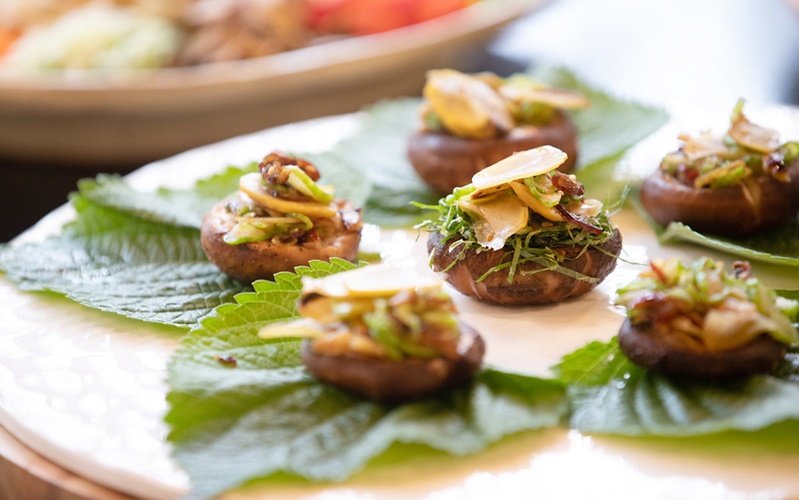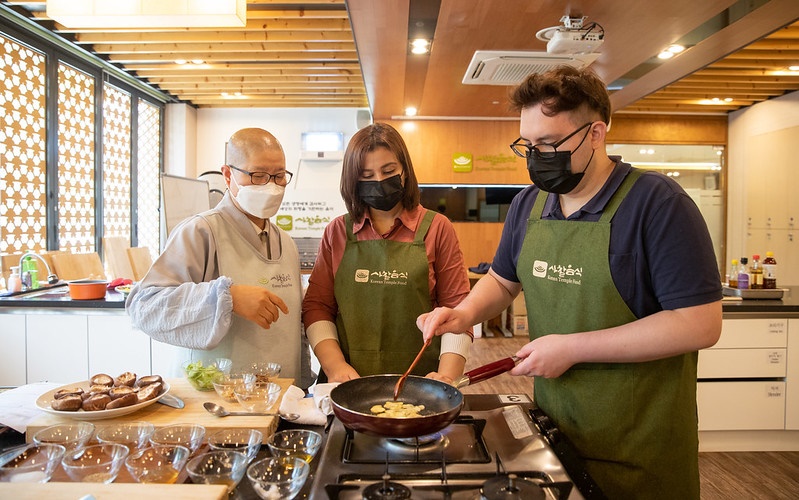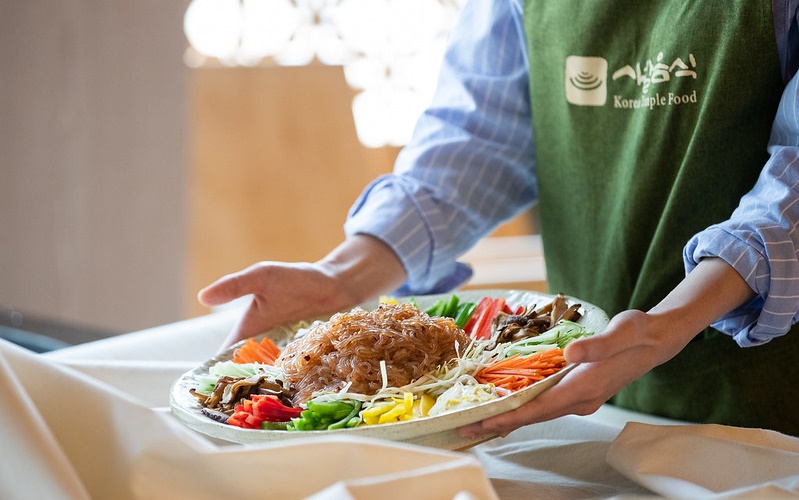
Pyogo mushroom sesame leaf ssam is part of Buddhist temple cuisine in Korea. The nutty taste of pyogo mushrooms, fragrant sesame leaves and sweet cucumber, chestnuts and walnuts create a rich flavor. "Pyogo mushroom sesame leaf ssam is a good temple food to serve to guests," said the Venerable Ji-kyun, an expert on the cuisine.
By Sarah Oqelee, Kim Yeojin and Joung Haseung
Seoul
Photos = Kim Sunjoo
A light and refined taste. The taste of each ingredient stands well on its own but creates harmony when merged together. Is this the taste of nature?
Korea.net staff writers had a surprising experience while trying food served at a Buddhist temple for the first time. Any doubts over how good it would be disappeared once the food entered their mouths. The mild taste with no irritation paradoxically triggered a stimulating taste.
The food served to monastics at Buddhist temples in Korea has a clean and refined taste because it lacks the five forbidden vegetables with a meaty or spicy taste -- green onion, garlic, chives, Korean wild chives and heunggeo (a type of leek) -- or oshinchae. The Buddhist diet excludes the five given the religion's bans on killing and meat consumption and promotion of detachment from delusion.
As healthy eating and vegetarian food are growingly popular, temple cuisine has seen its profile rise. In April, the France-based Le Cordon Bleu, one of the world's top three culinary schools, introduced a course on the cuisine of Korean Buddhist temples at its London campus.
Vegetarian restaurants specializing in temple cuisine are also gaining popularity. The Korea Vegan Union said the number of such establishments jumped 133% from 150 in 2010 to 350 in 2019.
To experience healthy temple cuisine, Korea.net staff writers recently visited the Korean Temple Food Center's Cultural Space in Seoul's Jongno-gu District. The Venerable Ji-kyun, a monk and expert in temple food, introduced the foods cold japchae (glass noodles mixed with vegetables) and pyogo (shiitake) mushroom sesame leaf ssam (wrap), both of which use summer vegetables as ingredients.
"The core of Buddhist temple cuisine is to extract as little as possible from nature and consume the food cleanly," the monk said. "It's the most nature-friendly food culture."
"The pyogo mushroom sesame leaf ssam and cold japchae recipes were developed so that people can easily make it at home with readily available ingredients."

Korea.net staff writers Sarah Oqelee from Egypt (center) and Elias Molina from Costa Rica (right) on May 28 make Buddhist temple cuisine at the Korean Temple Food Center's Cultural Space in Seoul's Jongno-gu District.
Two non-Korean staff writers of Korea.net said the food was far better than they thought. "The food tasted fresher because we used seasonal ingredients," Elias Molina from Costa Rica said. "I think tourists visiting Korea for a short time don't need to head all the way toward the mountains and can experience Buddhist temple cuisine in the heart of Seoul."
"I want to recommend temple cuisine for those who want vegetarian or halal food in Korea," Sarah Oqelee from Egypt added. "I want to eat healthy by learning more about the temple food menu."

To make cold japchae the Buddhist temple cuisine way, mix fresh vegetables with marinated cold noodles by hand. Making cold japchae Ingredients: 150 g of glass noodles; 30 g of pyogo (shiitake) mushrooms; 1/3 carrot; 1/2 cucumber; 50 g of mung bean sprouts; 1/8 cabbage; 1/2 green, red and yellow paprika Seasoning: red pepper powder, soy sauce, sugar, sesame oil, sesame seeds, pepper and vegetable oil. 1. Soak the glass noodles in cold water for about 30 minutes. 2. Julienne the pyogo mushrooms and season with soy sauce, sesame oil and pepper. 3. Julienne the carrots and paprika and peel the cucumber before julienning it. 4. Blanch the mung bean sprouts and season with salt and sesame oil. 5. Thinly julienne the cabbage, place it in cold water and drain the water. 6. Boil the glass noodles in hot water, rinse them in cold water, and season with salt and sesame oil after draining. 7. Add six tablespoons of vegetable oil, two tablespoons of red pepper powder and one tablespoon of sesame oil. Put it into a pan on low heat to create pepper oil and let it cool. 8. Place the vegetables around a plate. Season the glass noodles with pepper oil, soy sauce and sugar. Place the glass noodles in the middle of the plate, garnish with sesame seeds and serve. |
lvzhen@korea.kr